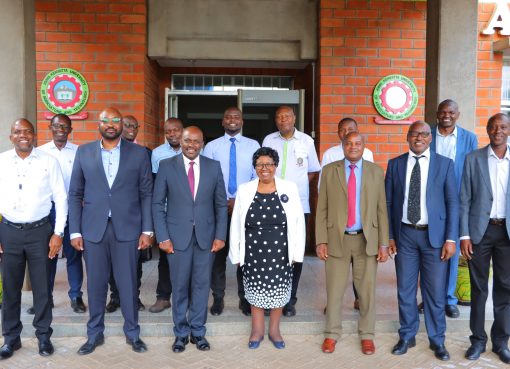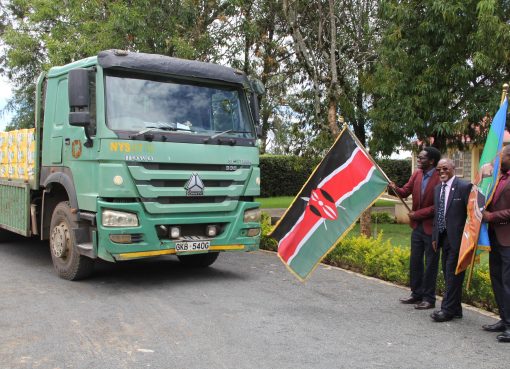On a late afternoon in November last year, rain clouds started gathering over the blue Taveta skies. Within a few hours, the clouds darkened into angry thunderheads. It was going to rain.
At around five in the evening, a massive thunderstorm landed. It lashed across the region with unprecedented fury as it buffeted trees and sent animals scampering for shelter. The deluge lasted for less than half an hour. That was all it took to trigger destructive flash floods that left dozens of herders in Mata ward with incalculable losses after over 300 sheep and goats drowned.

“Floods are the nightmare that keeps us awake. Whenever it rains, we are in trouble,” says Mr. Khatib Sandewa, an artisanal farmer at Machungwani in Taveta sub-county at the Kenya-Tanzania border.
However, it is not just the rains in Taveta that trigger extensive flooding in the area. The region also suffers flooding from rains in Tanzania.
Located on a lower altitude just a few kilometers from the higher areas of Kilimanjaro in Tanzania, heavy rains in the latter region ultimately ends up raging through Taveta; flooding farms, killing livestock and displacing hundreds of residents especially in the low-lying regions. The flooding is also exacerbated by the black-cotton soil that does not absorb water easily.
The flooding is not a new challenge in Taveta. Since the 60s, rich farmers including Captain Grogan had constructed deep canals to re-route litres of cascading floodwaters through vast farms and direct it all to Lake Jipe.
“Canals took the waters away from homes and guided it to the lake. However, due to heavy siltation, most canals blocked and flooding spread,” explains the farmer.
The irony of Taveta flooding is two-fold. While villages on the upper part at the mouth of the canals contend with flooding headache, several others villages on the lower zones where the canals cut across suffer from severe lack of water. Farms are dry and livestock must trek several kilometers to access water.
However, in the last several years, the county government through the department of Agriculture, Livestock, Fisheries and Irrigation has invested millions in equipment to desilt the blocked canals and built new ones to allow the flow of water. This move is being viewed as a long-term solution to combating flooding and increasing agricultural output in the region.
Mr. Francis Rongaine, the Ward Administrator on Boghoni Ward, says the exaction and desilting has allowed water to reach the remotest areas of Kitoghoto and adjacent regions. Until then, the areas had no access to water for irrigation.
“We have excavated several kilometers of canals and desilted others. Water is finally getting to residents of villages that did not have any,” he said.
Excavation data shows the county has been busy. To date, it has excavated 12-km of Njoro Kubwa Canal; 8-km of Kamliza Irrigation Scheme; 6-km of Maloja Canal and 50-km of Maloda-Majelu Irrigation Scheme. There are also plans to erect gabions at Riata and Machungwani to control the annual flooding episodes.
The County Executive Committee Member (CECM) for Agriculture Mr. Davis Mwangoma is upbeat that time and millions invested in desilting and canal-excavation in Taveta for flood control are bearing fruits. He adds that the aim is not just controlling the flooding but is also harnessing the waters for use in irrigation.
“When tapped effectively, this water can be of great benefit to farmers,” he said. He adds that more canals will be dug to permanently address this challenge.
Already, thousands of farmers are cultivating assorted crops including bananas, maize, beans and tomatoes. More farmers in Kitoghoto and upper parts of Kitobo have also started doing cultivation as canals take the water to their farms.
The official says agricultural production statistics for the last three years show a significant rise as compared to the past. Annual banana production has doubled while rice farming has shot up by over 30 per cent. There are expectations that production of other products including tomatoes, maize and vegetables from the targeted irrigation schemes will go up.
“The increase in harvest implies that we are gradually increasing our food security capacity as a region. We are also getting ready for expanded agri-business initiatives so that our farmers can benefit from this initiative,” he says.
Despite the success in managing the floods, challenges abound. The major issue is the constant clogging and blocking of canals from heavy siltation.
Mr. Joshua Mwangi, a banana farmer at Mrabani in Taveta, says the canals were in constant need of desilting. He pointed out that whenever it rained, tons of sands would flow with the waters from Tanzania and line the base. Over time, the canals become shallower and get invaded by invasive marine reeds that interfere with smooth flow of water.
He proposed the county water engineers filter the sand along the gullies before the water drains into the canals. He also suggested that the canals could be lined with concrete to ease the cleaning activities.
“We have not had flooding here and we don’t want it to start. However, if it rains, all the sand ends up here. That means the canals must be desilted. The county needs to tap the sand before it gets in the canals,” he said.
In other places like Msengonyi, siltation has diverted water on a road making it hard for residents to use it.
Mwangoma admits desilting is a challenge and an expensive activity to undertake. He disclosed that the county was in talks with the farmers to have farmers’ committee to be in-charge of managing the canals as part of entrenching sustainability.
“This is a community led initiative by the farmers. They will manage the canals and keep it clean. The county will offer the overarching support towards this end,” he explained.
Mr. Peter Letemaki, a farmer, also urged the county to extend the canals to the farmers on the upper sides where the gradient was too high to allow the water to flow using gravity. He added that hundreds of farmers were using generators to pump water on their farms and this was eating into their profit margins.
“The farmers on the lower side irrigate their farms using the flow of gravity. Those on the other side must buy petrol for their generators. County needs to excavate more canals to move the water closer to them,” he proposed.
By Wagema Mwangi





